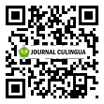THE ICONICITY OF DIRECTIONAL COMPLEMENT IN MANDARIN CHINESE
DOI:
https://doi.org/10.37301/culingua.v4i1.137Keywords:
Semiotics, Iconicity, Fuhe Quxiang Buyu??????, Complex Directional ComplementAbstract
Bahasa Indonesia does not have the complement of direction quxiang buyu ???? as Mandarin, because the Indonesians are not used to thinking iconically like the Chinese. That is, an idea is parallel to language. This parallel between thinking and language is called iconicity. The research question is what kind of directions are in the complement. The goal is to understand different types of direction complement, such as zoushanglai ???, paochuqu ???, xiexialai ???.. The theory used is Peirce's iconicity theory which is within the scope of semiotics. The method used is to compare word order with action-direction sequences so that parallelism between thought-language or iconicity is embodied in the form of complementary direction. This research shows that Chinese people always have compound directive words like VVlai or VVqu to explicit their mind towards or leave the speaker. This kind of idea is embodied in the form of a directional complement. The directional complement is posited after the predicate verbal. The result shows the visible likeness expressing the parallel is due to the parallelism of thought and language or iconic in semiotics.
References
Bybee, John.(1985). Diagrammatic Iconicity in Stem-inflection Relations. In John Haiman Iconicity in Syntax(pp. 11-48). Amsterdam/Philadelphia: John Benjamins.
Dippner, Kevin. (2010). Metaphorical use of Mandarin Compound Directional Complements. MA thesis (60 sp), East Asian Linguistics. Department of Culture Studies and Oriental Languages: Oslo University.
Haiman, John. (1980). The Iconicity of Grammar. Language 59.4:781-818.
Haiman, John. (1985). Natural Syntax: Iconicity in Syntax. Amsterdam/Philadelphia: John Benjamins.
Hiraga, Masako K. (2005). Metaphor and Iconicity: A Cognitive Approach to Analysing Texts. New York: Palgrave MacMillan.
H?bler, Axel. (2003). Spatial Iconicity in Two English Verb Classes. In Wolgang M?ller and Olga Fischer (Eds), From Sign to Signing: Iconicity in language and literature (pp 63-76). Amsterdam/Philadelphia: John Benjamins.
Jakobson, Roman. (1971). Quest for the Essence of Language. Selected Writing II: World and Language (pp.345-359). The Hague: Mouton.
Krampen, Martin (ed.) (1987). Classics of Semiotics. New York and London: Plenum Press.
Krampen, Martin. (1987). Ferdinand de Saussure and the Development of Semiology. In Krampen (ed.), Classics of Semiotics (pp. 59-86).
Marwoto, B.J. (2009). Kamus Latin Populer. Jakarta: Kompas Penerbit Buku.
Oehler, Klaus. (1987). An outline of Peirce’s Semiotics. In Krampen (ed.) Classics of Semiotics (pp. 1-20).
Ogden, C.K. & Richards, L.A. (1923). The Meaning of Meaning. London: Routledge and Kegan Paul.
Paskalis, Bossy & Hasanah, H.N. (2018). Ketepatan dan Variasi Pengguna Pelengkap Arah dalam Bahasa Mandarin dalam Karangan Pembelajar. Lingua, Vol.15, No.2:53-70.
Roose, Kristin. (2010). Using the Simple and Complex Directional Complements in Chinese for Beginners. Indiana: Ball State University Muncie.
Sasmita, M.U. & Junaeny, Arini. (2022). Analisis Kesalahan Penggunaan Kata Pelengkap Arah Quxiang Buyu ????Lai ?dan Qu ?pada Kalimat Bahasa Mandarin Siswa kelas XI Mas An Nuriyah Bontacini. Wen Chuang Journal of Foreign Language Studies, Linguistics, Education, Literatures, and Cultures, Vol. 1, Issue 2.
Saussure, Ferdinand de. (1916). Pengantar Linguistik Umum: Series Indonesian Linguistics Development Project, Translated from Cours de Linguistique Générale. Yogyakarta: Gadjah Mada.
Sutami, Hermina. (1999). Ikonisitas dalam Sintaksis Bahasa Mandarin. Doctoral disertation, Universitas Indonesia.
Sutami, Hermina. (2011). Aspektualitas dan Ikonisitas. In Ilmu Pengetahuan Analekta. Riris Toha Sarumpaet (ed). Depok: Faculty of Humanities, Universitas Indonesia.
Sutami, Hermina. (2011). Ikonisitas dalam Metafora. Paper presented in Seminar Forum Linguistik Pascasarjana 2011 “Penelitian Linguistik ke Arah yang lebih Mendalam” held by Laboratorium Leksikologi dan Leksikografi Departemen Linguistik Faculty of Humanities Universitas Indonesia. Depok: Fakultas Ilmu Budaya.
Sutami, Hermina. (2013). Ikonisitas dan Karakter Han. Paper presented in Seminar Semiotika, Department of Linguistics, Faculty of Humanities, Universitas Indonesia.
Sutami, Hermina. (2018). Korelasi antara Aspektualitas dan Ikonisitas. In Hakikat Ilmu Pengetahuan Budaya, Rahayu Surtiati Hidayat (ed.) (pp.315-330).Jakarta: Yayasan Pustaka Obor.
Liu, Yuehua et al. (2003). ???????? Shiyong Xiandai Hanyu Yufa. Beijing: Commercial Press.
Zoest, Aart van. (1993). Semiotika. Translated from Aart van Zoest, Semiotiek by Ani Soekowati. Jakarta: Yayasan Sumber Agung.
Downloads
Published
Issue
Section
License
Copyright (c) 2023 hermina sutami, Assa Rahmawati Kabul

This work is licensed under a Creative Commons Attribution 4.0 International License.









